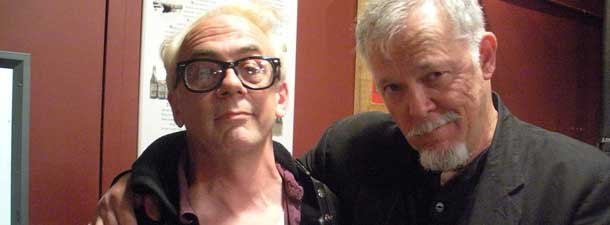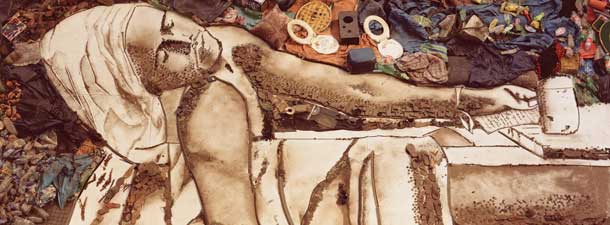
A Planet in Crisis: Can Art Save Us? Is it even trying?
September 2, 2012
RE-USE ME – The Creative Spirit Of Recycling Design
September 2, 2012Cartoonist/writer/editor/producer – OK, Renaissance Man – Mort Todd has had a storied career in comics, music, television, and film. He’s worked everywhere from Cracked Magazine to Walt Disney and with everyone from the Rolling Stones to John Kricfalusi. Childhood pal Michael Chandler has a chat with him about everything from Roy Lichtenstein – don’t get him started! – , his own media company “Comicfix”, and most especially, his stint as producer of the documentary “The Diabolikal Super-Kriminal” – about a 1960s Italian comic villain.
M
Mort Todd and I met when we were teenage, punk-rock high school students in Portland, Maine. I first knew him by his given name, Michael Delle Femine, and by his alias at that time, Dr. Death. We met at a house party, and he seemed to scan his landscape and turn what he saw and heard into an artistic conversational output. In the many years since, he has turned that talent into a career.
A short time after we became friends, Mort and I each moved to New York City. I ended up as a nightclub entertainer, and Mort had enrolled in the School of Visual Arts. He was, and remains, a very gifted cartoonist – if that does not insult the notion of “comic book artist” – as well as a writer, editor, and TV and film producer. At SVA, he studied under the legendary likes of Will Eisner and Harvey Kurtzman, while plunging into the New York underground comic art, music, and television scene. Perhaps as a result, he did not graduate from SVA.
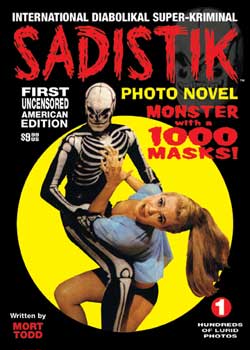 |
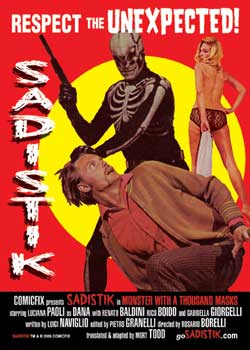 |
A few years after non-matriculation and with a few deviant comic book credits and a television pilot (featuring underground hero, Dan Clowes) on his resume, Mort was hired as Editor-in-Chief of Cracked magazine, the arch-nemesis of Mad magazine, from whom Mort stole none other than American comic book icon, Don Martin. Already on Cracked’s roster was John Severin, later to be joined – through Mort – by Spiderman co-creator Steve Ditko, and neophytes Peter Bagge, Dan Clowes, and Rick Altergott.
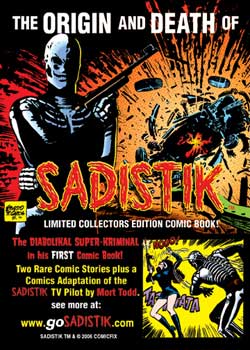 SADISTIK issue |
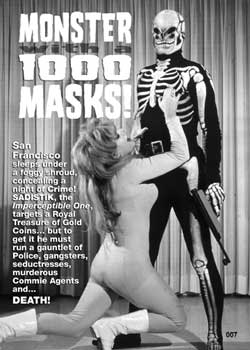 |
From Cracked, Mort moved to become Editor-in-Chief of the Marvel Music imprint, during which time he worked alongside the likes of the Rolling Stones and Kiss to release graphic novel-style biographical comics. Throughout his magazine years, Mort was also the exclusive LP cover artist for Crypt Records’ Back From the Grave series, work that harkened back to Delle Femine’s childhood horror-comics roots.
In recent years, inking and producing to the beat of his own drummer, Mort has exhumed and reintroduced to the psycho-comic and wackoid-cinema world, an Italian original, a multinational character of evil and intrigue from the 1960s, which he renamed, “Sadistik,” for his Comicfix imprint.
I had to ask my chum:
What the hell is Sadistik: Diabolikal Super-Kriminal all about?
MORT: When I was a little kid, I was a big fan of this Italian film, Diabolik. It was also called Danger: Diabolik. It was directed by Mario Bava, and it kind of presaged the whole Batman [1960s TV series/movie] thing. And there were comics too. Really, Italy has a tradition of “super-villains” as opposed to superheroes, and you could equate this guy’s popularity to Batman’s in America in the 1960s. Back then, the Diabolik comic character was really big in every country except the United States.
That’s the case even today. They were shooting the Diabolik movie at the same time they were shooting Barbarella, and both movies had some of the same actors.
I gotta tell you, Diabolik is a much superior film.
So I was looking to get the rights to the character to reprint the Diabolik comics here in America, but it was – whoosh – way too expensive.
As I’m talking to the guys about this, one of them says that he’s aware of a property that was similar, that they wanted to sell outright, that was a lot cheaper than Diabolik. That turned out to be pretty damn cool, and I’ll tell you why.
This whole thing started in Italy with Diabolik, the movie, and the comic books. Then there were characters called, Killing, and Kriminal who each had another group of pulp magazines in other countries. These were magazines known as “photo novels,” (black and white photo stories with caption balloons) that were big all over the world, again, except in America.
So the movie, Danger: Diabolik, just set you off on this?
MORT: I saw Danger: Diabolik when I was a kid. A long time after that, I found out about the Turkish photo comics. I didn’t know about the movies. I started digging through Video Watchdog, and I found out that there were these movies that were based on the photo comics. I hunted around for the movies, and there were about a dozen bootleg films that they shot in Turkey from the mid-60s through the 1970s, and they were . . . just insane.
They would take the Sadistik character, and they would put him in – well, they did a few blatant rip-offs of the photo novels, but then they would put him in a Western setting. Or have him meet Frankenstein. Or, actually, in the first movie, he went up against a Super-Batman. They would just rip off James Bond soundtracks too. They didn’t care about any copyright laws back then. So when this guy told me that the rights were available, I just said, “Gimme.”
Then this “photo-novel” comic character, based on the movie, Diabolik, grew in both underground and popular culture?
MORT: He was phenomenally big. In Turkey, they called him, “Killink.” Germany, France, they both had their versions of him too. He had a different name and a different spelling in every country. In France, he’s known as “Satanik.” So all these criminals had a k in their names – I guess they got it from “sputnik” or something. I made up the name “Sadistik” to try to combine the different versions.
Then I used “Diabolikal Super-Kriminal” to kind of tie all of the brand names together.
The only photo comics I can recall from the USA were National Lampoon Magazine’s “Foto Funnies,” from the 1970s.
MORT: Well, yeah, photo comics are rare from America, but I’m such a geek for that stuff that I dug around. And about all I came up with, other than “Foto Funnies,” were a couple of movie and TV adaptations that were photo mags with captions. I also did a photo comic while I was at Cracked.
Do you think that the idea of a photo novel could have been at all propelled by Roy Lichtenstein’s art?
MORT: Oh, come on! [Laughs heartily.] Don’t get me started with that one. I know a lot of the artists he swiped from, and it’s criminal. The guy is a fuckin’ forger, and he’s shitty forger. These guys he stole from were getting five bucks a page, a buck and a quarter a panel for what this fucker is getting fourteen million for.
Oops. Well, speaking of marketing, you surely didn’t get into the whole Diabolikal Super-Kriminal thing just for the print aspect.
MORT: Hell no. The whole thing for buying a property is, “Oh boy, let’s make some movies and a TV show and some action figures.”
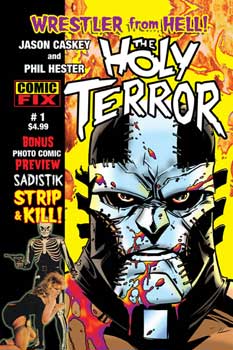 The Holy Terror |
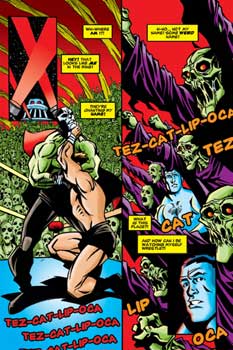 |
You were the producer of an Italian documentary called The Diabolikal Super-Kriminal, and as I understand it, you got to wear the original “Killing” character’s mask.
MORT: That’s right, and I need to give credit to the costume designer, Carlo Rambaldi for designing the original costume. But it’s funny; even though these were photo novels, the actors were in tons of movies – spaghetti westerns, science fiction, soft-core porn, horror, slasher movies. So in these books, a lot of times I’ll add filmographies of these actors, because it’s fascinating, their whole careers.
When we did the documentary, we had this whole spectrum of some of the actors who had held onto their props, and then some others who said, “I… um… don’t remember doing this. I guess I must have needed the money.”
The director of the documentary, SS-Sunda, did a fantastic job tracking down all the original actors, and believe it or not, there was only one guy who played Sadistik over sixty-six issues of the magazine.
Since you never saw his face, you’d think that they could have just gotten anybody. In fact, it was only one actor, who was under contract never to reveal who he was. Even when he was on the set or on locations, he couldn’t take his mask off. So when the director started looking for all the actors, nobody either knew or could remember who was the guy who played Sadistik.
A lot of the intrigue in the documentary is based on trying to find out who played him. Ironically, it turns out that he’s a hugely famous TV sportscaster named Aldo Agliata that probably half of Italy would recognise. He’s like their Regis Philbin.
It’s funny that the actor would now be a household name and face, because the Sadistik character is really unrepentant when it comes to violence and showing no mercy to his victims. Not to mention, he’s very sexist, even by older standards.
MORT: As I’m translating from Italian to English, a lot of times I’ll add stuff to the stories, not just to make it more interesting to the readers, but in the magazines, they never reveal his face or give any of his origins or anything like that. So I came up with a back-story from World War II to the 1960s. Then I put some of those elements into some of the issues to create this bigger mythology.
You might wonder, what are his motivations? Why is he a “Super-Kriminal?” So I usually try to stress the fact that he does not initiate the violence. A lot of times I get comments like, “Hey, he’s tying up girls in their underwear.” And I have to say, hey, they started it, because they’re usually these strong, feministic women trying to further their careers in crime, and they’re usually involved in some scam to try to screw Sadistik over first. So I don’t think there’s anything objectionable about that.
I wonder how that attitude nestled into Italian culture in the 1960s. What do you figure was Sadistik’s appeal back then?
MORT: I think around that time, the Catholic Church’s hold in Italy and the Christian Democracy Party had started to wane, and other types of films like neo-realism came in, and there was nudity. This is a time when people started doing really brutal horror films and stuff, so Sadistik was just a by-product of that.
What do you figure is Sadistik’s appeal today?
MORT: It’s obvious that in popular culture comic characters are bigger than ever, and the American audience has caught up with the idea of the anti-hero protagonist. Traditional superheroes are now darker – like Batman, Spiderman, and even James Bond. There has always been an appeal for a character who is bold, independent, and in his career in crime-fighting, successful. And he gets the girls!



